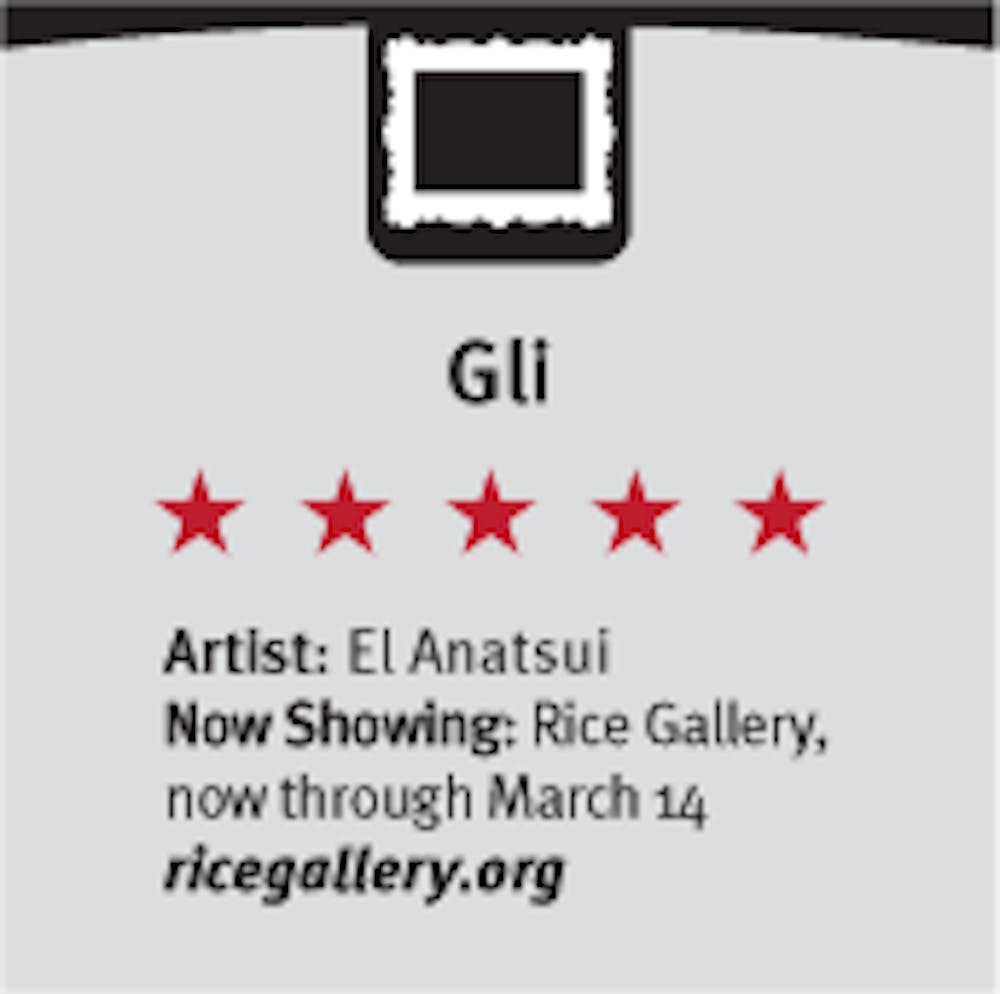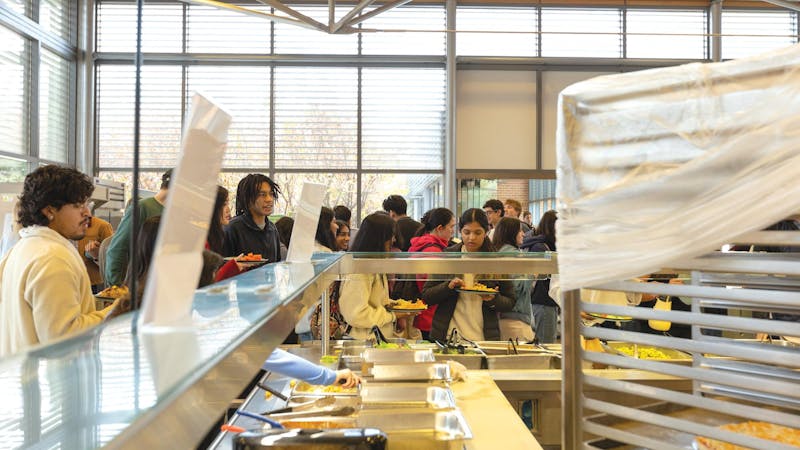Breaking down barriers

It is Monday, and a tangible sense of excitement and raw creativity fills the Rice Gallery as volunteers and various gallery staff work to install El Anatsui's new piece, Gli, into the space. An industrial elevator allows workers to connect large sheets of flattened bottle caps to fishing line suspended from the ceiling. Kim Davenport, the gallery's director, converses with her colleagues regarding the proper positioning of the sheet in relation to the overhead lighting. The industrial logistics that make a work like Anatsui's 20-foot-high installation a reality contrast sharply with the overall aesthetics of the final product.
Suddenly, the sheet disconnects from the fishing wire and the entire piece comes crashing down in a cacophony of clangs. Such an incident would usually incite panic in the hearts of most gallery workers, but the durable bottle cap medium remains unharmed. Now on the floor, the caps are surrounded by large segments of aluminum refuse. This combination of industriousness and garbage makes it abundantly clear that Anatsui's work - and artistic mentality - are quite different from those other more controlling, fastidious modern artists.
During the general mayhem of the installation process, Anatsui sits quietly and calmly in a corner, removed from the group that attempts to puzzle together the "perfect" position for the piece, and he shows no signs of worry or distress when his work comes thundering to the ground. He does not even assert himself, leaving creative decisions to those assembling his work. Yet his presence permeates the gallery as only the company of a world-renowned artist can.
Anatsui is a native of Ghana, but he has been working at the University of Nigeria since 1975. Throughout his career, his work has demonstrated a continual evolution in medium. His first shift was from wood to clay, before an eventual transition to the metal and aluminum he now uses.
The inspiration for Anatsui's latest pieces, which have permanently solidified his place in the global art world, was a bag of garbage he found in the Nigerian countryside in the late 1990s. After mulling over what to do with the bag, which contained aluminum tops of various liquor bottles, Anatsui began to flatten the tops and stitch them together with copper wire, producing a sheet that resembled a giant section of metal cloth.
Anatsui's new installation, Gli, uses the same principals he mastered while creating his first works with metal. However, the installation also demonstrates the evolution of Anatsui's conceptual and aesthetic vision. As a site-specific artwork, Gli was designed with the openness and spaciousness of the Rice Gallery in mind. Anatsui was intent on allowing his piece to coexist with the space, highlighting the gallery's high ceilings and broad width.
In order to further elucidate and highlight the structure of the room, Anatsui turned his creative spirits to the idea of a wall. Within the last year, Anatsui visited Berlin, Jerusalem and Togo, noting the common factor of the walls, both physical and ideological, which linked the three locations together in spirit. In the Berlin Wall separating Western Europe from the communist Eastern Bloc and the Wailing Wall in Jerusalem fundamentally dividing the Israelis and Palestinians, Anatsui realized that walls, wherever they are, symbolize obstacles and barriers.
Additionally, and on a more personal level, Anatsui registered his work's connection with west African history by keeping in mind the legendary Togolese wall built by a tyrannical king to separate the region from Ghana. Anatsui described how the clay wall, 12 feet thick, provided security for the king at the cost of "subjugating and closing in the people" of Ghana. But though the wall formed a physical barrier for the Ghanaian people they, like all people, searched and "looked for ways to break the wall."
Anatsui believes that walls are "something that can close you in," though they also incite a sense of curiosity in the individual trapped on one side of the divide. Walls titillate the imagination and provoke the individual to leap mentally over the wall to picture what is on the other side. According to Anatsui, a wall reveals more than it hides, and thus it challenges the individual to use his or her imagination to surmount physical obstacles.
It is easy to see this concept of a wall within Gli, which opened to the public yesterday and will host a talk by Anatsui today at noon. The title of the installation is actually the Ewe word for wall, disrupt and story, further reinforcing the interplay between the paradoxical qualities of physical limitations and mental freedom contained in the notion of a wall. Anatsui's installation is comprised of two giant sheets of connected, flattened aluminum screw tops suspended from the ceiling, raising the "wall" to the very top of the ceiling.
However, unlike his other works in this medium, Gli retains a clear sense of transparency. Since the first sheet is hung in front of the other, the viewer's vision of the second sheet is slightly obscured. Gazing through the myriad flattened metal pieces forms a slightly distorted vision of the other sheet. The mind quickly jumps to its own conclusions regarding the exact composition of what is occurring on the other side of the first metal sheet, much like those on one side of a wall surmise what is happening on the other side.
An overall textural quality enhances the visual pleasure of the installation. Thicker dimensions of aluminum cluster in waves in the upper portions of the sheets, eventually tapering to a thinner, more translucent form. The numerous metallic colors blend together in a homologous manner, continuously stimulating the eye, all the while avoiding distracting the viewer from the overall effect.
Gli is a magnificent installation carrying a thought-provoking message. In addition to the meaning behind natural walls, Anatsui's unique medium speaks to themes in current African art, such as globalization and the permeation of Western consumer culture. But through a sense of grand optimism - enough optimism to entrust the piece's installation to complete strangers, in fact - it is clear that Anatsui harbors a great belief in the power of individuals to overcome any barrier with their imaginations.
More from The Rice Thresher

Over 1,000 students petition against new meal plan
When Konstantin Savvon opened the Housing and Dining email announcing the new unlimited meal plan, he was instantly concerned about the impact on off-campus students like himself.

Rice football wins season opener under new coach
For the first time since 2018, Rice football opened its season with a victory. Scott Abell was soaked with yellow Powerade following a 14-12 win on the road Saturday against the University of Louisiana at Lafayette, which won 10 games and made it to the Sun Belt Conference championship last season.

Acting like an athlete: Rice basketball alum takes on Broadway
Underneath Chadd Alexander’s Broadway costume, there’s ankle tape and wrist braces — same protective gear he wore as a walk-on basketball player at Rice, though now he’s performing eight shows a week in the ensemble of “Harry Potter and the Cursed Child” instead of running conditioning drills in Tudor Fieldhouse.

Please note All comments are eligible for publication by The Rice Thresher.